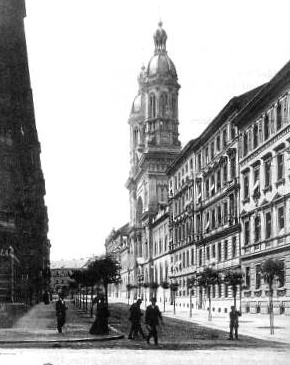
Po obcanské a hospodárské emancipaci v polovine 19. století se mohli Židé usazovat i v nove vzniklých ctvrtích a predmestích rychle se rozvíjejícího mesta. I v techto nových mestských cástech si Židé zrizovali modlitebny, hrbitovy a synagogy. Nejvetší i nejhonosnejší z nových synagog byla postavena na Královských Vinohradech v letech 1896-98 v dnešní Sázavské ulici podle návrhu vídenského architekta a c. k. stavebního rady Wilhelma Stiassnyho.
Wilhelm Stiassny (1842 - 1910) byl zajímavou osobností. Významne se zasloužil o rozšírení výrazových prostredku architektury v poslední ctvrti 19. století, prekonal klasický historismus, založený na rekonstrukci slohových forem drívejších epoch, a stal se jedním z tvurcu architektonického eklektismu. Snažil se všemožne podporovat sociální a kulturní programy židovské komunity a svými umeleckohistorickými studiemi a rekonstrukcemi prispel k rozšírení zájmu o židovskou historii a památky. V Cechách postavil ctyri významné synagogální stavby: v Jablonci nad Nisou (1892), nejvetší pražskou synagogu na Královských Vinohradech (1896-98), synagogu v Cáslavi (1898-99) a nakonec nejmladší pražskou synagogální stavbu - chrám v Jeruzalémské ulici (1905-1906). Zatímco pro stavbu Vinohradské synagogy byl zvolen monumentální a ponekud strohý novorenesancní sloh, obe dosud zachovalé synagogy v Cáslavi a v Jeruzalémské ulici se zdají daleko zajímavejší.

Reprezentativní budova v neorenesancním stylu se svým východním prucelím do ulice se pyšnila dvema vysokými vežemi. Nádherný a pompézní byl i interiér synagogy, ženská galerie byla tvorena otevrenými arkádami do hlavní lode. Aron ha-kodeš (schrána na tóru, oltár), tradicne orientován na východ, byl vytvoren ve forme miniaturního orientálne-byzantského chrámu s antickými sloupky. Celá stavba byla výrazem zámožnosti zdejšího židovstva. Budova mohla pojmout na 2000 verících, címž se radila mezi nejvetší synagogy, nejen v Evrope, ale i na svete. Dochovaná plzenská Velká synagoga se stejným poctem míst je dnes tretí nejvetší stavbou tohoto druhu na svete.
14. února 1945 (dnes je to na svátek svatého Valentina) probehl necekaný nálet amerického letectva na Prahu. Jednou z nejvíce zasažených ctvrtí bylo horní Nové Mesto a Královské Vinohrady. Vážne byla poškozena také synagoga, takže musela být v roce 1951 stržena. To souviselo asi i s tím, že židovského obyvatelstva na Vinohradech moc nezbylo. Na jejím míste dnes stojí základní škola (jejíž provoz byl zahájen 1. zárí 1961), na které je pametní deska.
Je to místo, která s pražskou topografií Kafkova života rovnež souvisí. Jednak je to Kafkuv pobyt na Vinohradech ci Kafkovo spoluvlastnictví „továrny“ na Žižkove, ale predevším Kafkova vinohradská snoubenka Julie Wohryzková, jejíž otec byl sluhou ve vinohradské synagoze.
Pametní desku najdete na puvodním míste synagogy (viz. waypoint) u vchodu do školy.
After civil and economic emancipation in 1850s, Jews were allowed to settle in newly-established town quarters and suburbs of the fast-growing town. Even in these new town parts, Jewish cemeteries and synagogues came into being. The biggest and most magnificent synagogue was built in Vinohrady between years 1896 and 1898 in today’s Sázavská street according to a plan by the architect Wilhelm Stiassny.
Wilhelm Stiassny (1842 - 1910) was an interesting personality, who played an important part in development of architecture. He supported social and cultural programmes of the Jewish community and with his reconstructions and art-historical studies contributed to widening the interest in Jewish history and monuments. He built four synagogues in the Czech Republic – in Jablonec nad Nisou (1892), in Vinohrady (1896-98), which became the biggest one in Prague, in Cáslav (1898-99), and in Jerusalem street in Prague (1905-6), which became the smallest synagogue-like building in Prague. While the synagogue in Vinohrady was monumental but quite severe in style, synagogues in Caslav and Jerusalem street, which remained to date, seem far more interesting.
This representative neorenesance building had two high steeples facing the street. Beautiful and pompous was the interior, as well. The women gallery was formed by arcades open into the nave. Aron ha-kodeš (the case for tora, the altar), traditionally facing the east, was built in the shape of a tiny oriental-byzantine temple with ancient pillars. The whole building was the reflection of the wealth of local Jews. It had the capacity of 2000 people, which made it, at its time, one of the biggest synagogues not only in Europe, but even in the whole world. The Great Pilsner Synagogue, which has the same capacity, is today the third biggest synagogue in the world.
On 14th February 1945 (today’s Valentine Day), an unexpected attack of the American aircraft happened in Prague. The most damaged parts were the New Town and Vinohrady. The synagogue was badly damaged and had to be pulled down in 1951. This was caused also by the fact that there weren’t many Jews in Vinohrady any more. These days, a primary school stands where the synagogue used to be (the school was established on 1st September 1961).
This place is also connected to the life of the Jewish writer Franz Kafka. It’s firstly Kafka’s temporary stay in Vinohrady and his co-ownership of a “factory“ in Žižkov, but the most important connection was his fiancé Julie Wohryzková, whose father used to be a servant in this synagogue.
You can find a memorial plaque at the original site of the synagogue, near the entrance of the school. (see waypoint)
Dekuji DeathOfRats za pomoc s prekladem.